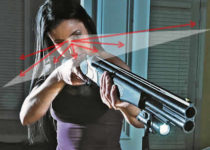
Mossberg 590A1
For When You Need a War Shotgun
Story and Photos by Frank JardimIf you do your bird hunting with a classic Mossberg 500 shotgun, you might be taken aback when you first handle their tactically oriented, nine-shot, bayonet-lug- and aperture-sight-equipped Magpul series Model 590A1. For starters, the 590A1 is built for war, not sport, and the Magpul series takes it a step beyond with furniture that enhances its tactical function and allows for more user customization than the standard military stock. Whether you’re repelled by it or drawn to it, you have to admit: it’s a sexy beast. At nearly 8.5 pounds empty, I found this model’s weight alone impressive. It’s a load to carry, which means any Marine Corps infantryman issued one will curse it long and loudly, but when it comes time to shoot it, that mass just soaks up the recoil of the heaviest 3-inch magnum loads.
This is a gun you can shoot slugs with all day long. I don’t love this gun, but it’s an apocalypse-grade weapon. If I have to go into battle against a rival warlord or endure decades of chaos after the collapse of civilization with just a shotgun, this is the one I’d want.

The Mossberg 500 in tactical trappings was also very popular with law enforcement, but its most demanding role was serving in the hands of our military service members in combat in Iraq and Afghanistan. In fact, the changes that evolved the series 500 into the current 590 and 590A1 tactical shotguns were in response to the military’s requirements.
Though non-NFA versions of the 590A1 with barrels 18.5 inches or longer became available to civilians in 2009, these shotguns are marketed primarily to law enforcement and military agencies. The 590A1 is among the mix of shotgun models and types the military currently uses for interior guard duty, prison security, riot control, door-breaching, boarding hostile naval vessels and front-line combat roles.
However, in the big picture, the shotgun is a specialty weapon and makes up a very tiny percentage of our military small arms inventory. Shotguns have served our troops most famously in the trenches of World War I, and the jungle fighting in the Pacific Theater in World War II and the Vietnam War, but always in small numbers. Unlike military service rifles, which are designed as combat arms from the first blueprint, shotguns and their ammunition were always selected and procured from normal civilian commercial sources, sometimes with no modifications whatsoever, other than the addition of martial markings.
For the most part, this worked out fine for the military, though there was a noteworthy problem with the original standard paper-hull shotgun shells in wide civilian use before the Vietnam War. It was found that in wet climates, like the jungle for example, paper hulls absorbed moisture and swelled up to the point that they couldn’t chamber, rendering the shotgun useless, other than as a melee weapon! The solution to this problem was an expensive all brass shotgun shell.
By the 1960s, the plastic-hulled shotgun shells we know today were replacing the black-powder-era paper hulls. The plastic-hulled shell was the perfect economical solution to the military’s shotgun ammunition spoilage problems in tropical climates. However, one major problem remained and persists to this day. Because of the weight and physical size of shotgun cartridges, military personnel armed with shotguns for combat have always had a hard time carrying enough ammunition to stay in a firefight.
GETTING BACK TO the specific tactical adaptions of the Mossberg shotguns, the principal difference between the 500 and 590 was the design of the magazine tube and barrel mounting. The former’s magazine tube is closed at the end with a threaded hole in the center to attach the barrel. The latter uses an open-ended magazine tube with exterior threads and holds the barrel in place with a screw-on cap.

This made the 590’s magazine much easier to clean. That wasn’t a big deal for most American hunters, but it was for airmen, soldiers and marines, who tended to get a lot of sand and dust in their guns doing their duty during the Gulf Wars and the Global War on Terrorism. The 590A1 differs from the 590 in the thickness of its barrel and its use of aluminum, rather than polymer, for the triggerguard assembly and safety. It doesn’t take too much to dent a shotgun barrel, and the U.S. Navy requested a heavier barrel that was more resistant to denting after observing guns were sometimes damaged banging into ship hatchways. At the muzzle, you can see a 590A1 barrel is about twice as thick as a standard weight barrel and it’s actually too thick to use the standard 590’s heat shield. By the way, heat shields were originally ordered for military shotguns in World War I, when the use of a bayonet in combat was expected. In bayonet training, the supporting hand grasps the front of the weapon around the barrel and front grip and is subject to burning without some sort of thermal shield.
Today, only the wooden-stocked 590A1 Retrograde is offered with a specially fitted heat shield, though several other 590A1 models have a bayonet-lug/auxiliary-magazine-tube support silver-soldered to their barrels. The bayonet setup will fit all bayonets designed for the M16/M4 series of service rifles up to the present M9 and USMC OKC-3S bayonet.
From a reliability standpoint, the 590A1 is as good as or better than its predecessors, and that’s saying it’s very, very good. It features dual extractors on the bolt, positive steel-to-steel lockup between bolt and barrel, twin action bars on the operating slide (a feature once unique to the Remington 870 until their patent expired in 1970), and an anti-jam elevator to ensure smooth operation. Left-handers have always appreciated Mossberg’s safety mounted on top of the wrist for ambidextrous operation. In these respects, all current 500s, 590s and 590A1s are alike. They differ in stocks, sights, barrel lengths, magazine capacity and finish.

The Magpul (magpul.com) SGA buttstock is ambidextrous in the sense that it has a 1.25-inch sling loop and QD socket on each side and the steel ring for hook attachment at the stock wrist can be positioned on the right or left side. This user-configurable buttstock is adaptable for use with body armor, optics and shooters of differing stature. Length-of-pull is adjustable from 12.5 to 14.5 inches in half-inch increments with a spacer system. The butt is capped with a soft recoil pad that goes a long way toward making this gun pleasant to shoot.
The grip has aggressively textured side panels, a grooved front strap and, most importantly, improved ergonomics somewhere between a traditional stock and a vertical pistol grip. The effect of this geometry is that it keeps your thumb from painfully banging into your nose during recoil but still permits a full, tight, wrap-around grip. The comb height is also adjustable with optional cheek risers for use with optics and raised sights. All of these adjustments require simple hand tools and aren’t adjustable on the fly.
Wear Blue..and Take 25% OFF

The Magpul MOE M-Lok forend has integral front and rear hand stops and is quite narrow along the top where the M-Lok slots are. This is really good since this is the part of the tactical shotgun that tends to grow exponentially when you add accessories. It’s a little bit longer than standard, but the extra length is to the front so it doesn’t ride over the receiver in the rear and won’t interfere with a sidesaddle ammo holder. The two best features are the M-Lok slots along the top edges and bottom for mounting the accessories of your choice. The Magpul buttstock and forend come in black, flat dark earth, stealth gray and orange.
Though any weapon with front mounting space always tempts me to attach a battery-powered, lightup, 1950s-kitsch, miniature dancing Hawaiian hula-girl lamp, I took the mature road and attached an AimShot (aimshot.com) TX890 Wireless Revolution tactical light instead.
Other than an aiming laser, a light is the only accessory that makes any sense on a shotgun. The AimShot’s Wireless Revolution light comes with a direct-attach rail mount and a throwlever, quick-release-style adapter, if you want to take it on and off like I do. To mount the light, I attached a section of Picatinny rail on each side of the forend for the light and wireless switch. Alternatively, I could have used AimShot’s quick-release M-Lok mounts instead for a cleaner, slightly lower-profile installation of this tough, compact, waterproof, 550-lumen light. Even though it has a wireless switch, you can still operate it with the tail switch as redundant backup or a primary switch when dismounted from the gun for handheld use.
One other advantage of the wireless switch is it allows light output to be adjusted from 5 percent to 100 percent as needed. The MSRP on this unit is $179. The rugged forward sling mount is designed specifically for the heavy barreled 590A1 and features a cast steel hook attachment point on one side and a standard QD socket on the other side.
It’s secured to the gun with a pair of wings that grip the barrel and magazine tube. This allows the use of any push-button type QD sling swivel and just about any one-point, clip-instyle attachments (i.e. MS3 Paraclip, the HK hook, ITW MASH hook, etc.).
The whole thing is Melonite-treated for wear- and corrosion-resistance and is simply indestructible. The downside is you can’t take the barrel off with it on.
If you must have sights on your shotgun other than a front bead, the XS Sights combination ghost ring rear sight and receiver Picatinny rail is about as fine a choice as you could make. The sight and base are made of stress-proof steel and adjustable for windage and elevation with a screwdriver.
The rail section is aluminum and mounts to the receiver through pretapped holes. The sights are at such a height that they can be co-witness with a red-dot optic mounted on the rail portion. The large diameter hole of the ghost ring aperture allows for fast target acquisition, but still permits a good degree of precision.
Slug hits at 100 yards on man-sized targets aren’t a problem. The only thing I kind of wish this excellent sight had is the military style wing protectors on each side. That being said, XS Sights are known for being extraordinarily tough. The 590A1 front sight is also drift adjustable for windage if need be.

With the 590A1, I could just enjoy blasting stuff for the sheer fun of blasting stuff. Still, this is not a gun well suited to most women or any youngster. Santina Warthen, the model who worked with me on the photos for this story, is one of the exceptions. An athletic 5-foot-10, she shot it like a champ. The Mossberg 590A1 is covered by a 10-year limited warranty. For more information on it and other Mossberg products, visit your local gun store or mossberg.com.




